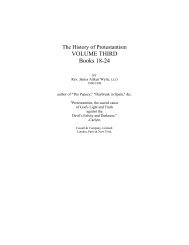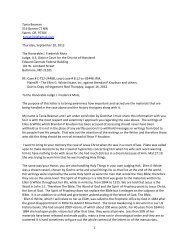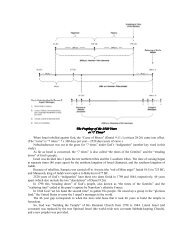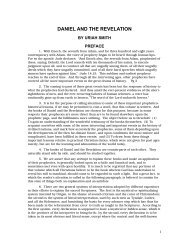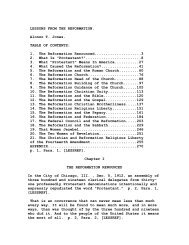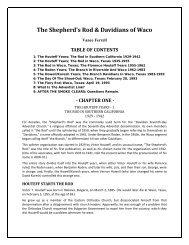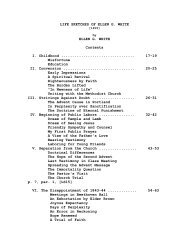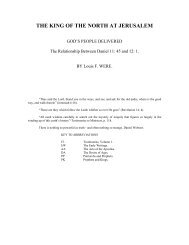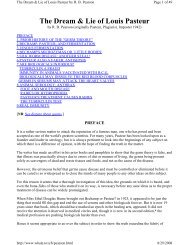LOOKING UNTO JESUS OR CHRIST IN TYPE AND ANTITYPE. BY ...
LOOKING UNTO JESUS OR CHRIST IN TYPE AND ANTITYPE. BY ...
LOOKING UNTO JESUS OR CHRIST IN TYPE AND ANTITYPE. BY ...
You also want an ePaper? Increase the reach of your titles
YUMPU automatically turns print PDFs into web optimized ePapers that Google loves.
other symbols. p. 154, Para. 4, [<strong>LOOK<strong>IN</strong>G</strong>].<br />
This little horn of Daniel 8 does not symbolize Antiochus<br />
Epiphanes, but it does symbolize Rome. To prove this is<br />
easy. If people would only treat interpretations of prophecy<br />
as they treat bank-bills, that is, compare them with<br />
the detector to see if they are genuine, there would be no<br />
trouble. The only wonder is that any one could ever have<br />
supposed the application to Antiochus to be correct. p.<br />
155, Para. 1, [<strong>LOOK<strong>IN</strong>G</strong>].<br />
The proposition here affirmed, then, is that the little<br />
horn of Daniel 8 does not symbolize Antiochus, but does<br />
symbolize Rome, because,-- p. 155, Para. 2, [<strong>LOOK<strong>IN</strong>G</strong>].<br />
1. This horn came out of one of the four horns of the<br />
goat. Verse 9. It was therefore another horn separate and<br />
distinct from any of the four. One of these four horns, as<br />
we have seen, was the kingdom of Syria, founded by Seleucus,<br />
from whom sprung the famous line of kings known in<br />
history as the "Seleucidae." Of these there were twentysix,<br />
in order as follows:-- p. 155, Para. 3, [<strong>LOOK<strong>IN</strong>G</strong>].<br />
(1) Seleucus Nicator, (2) Antiochus Soter, (3) Antiochus<br />
Theus, (4) Seleucus Callinicus, (5) Seleucus Ceraunus, (6)<br />
Antiochus the Great, (7) Seleucus Philopater, (8) Antiochus<br />
Epiphanes, (9) Antiochus Eupator, (10) Demetrius Soter,<br />
(11) Alexander Bala, (12) Demetrius Nicator, (13) Antiochus<br />
Theos, (14) Antiochus Sidetes, (15) Zebia, (16) Seleucus,<br />
son of Nicator, (17) Antiochus Grypus, (18) Antiochus the<br />
Cyzicenian, (19) Seleucus, the son of Grypus, (20) Antiochus<br />
Eusebes, (21) Antiochus, second son of Grypus, (22)<br />
Philip, third son of Grypus, (23) Demetrius Eucheres, (24)<br />
Antiochus Dionysius, (25) Tigranes, (26) Antiochus Asiaticus,<br />
who was the last of the Seleucidae, and who, after an<br />
insignificant reign of four years, was driven from his dominions<br />
by Pompey, the Roman, B.C. 65, and Syria made a Roman<br />
province. p. 155, Para. 4, [<strong>LOOK<strong>IN</strong>G</strong>].<br />
It will thus be seen that Antiochus Epiphanes was simply<br />
one of the twenty-six kings who constituted the Syrian horn<br />
of the goat. He was for the time being that horn; hence he<br />
could not be at the same time a separate and independent<br />
power, or another remarkable horn, as the little horn was.<br />
p. 156, Para. 1, [<strong>LOOK<strong>IN</strong>G</strong>].<br />
Rome was such a separate horn, and, from the standpoint of



